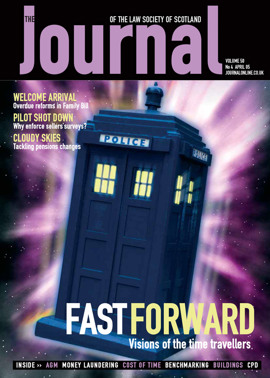Sell or transfer?

Family law practitioners will be familiar with the problem. The parties separated some months ago, or not unusually, some years. The wife/mother continued to reside in the jointly owned matrimonial home; the husband/father continued to pay the mortgage while living in temporary rented accommodation. At some point one or both parties want to “sort things out”.
If your client is the husband in the typical situation outlined above, he may point out, as you advise of the requirement in the Family Law (Scotland) Act 1985 to identify and value the matrimonial property at the relevant date, that the home was worth, say £250,000 at separation but is now worth around £400,000 two years later. He would now like to sell the home in order to buy a suitable property for himself; his wife wants to stay in the house but he says she is being unrealistic.You tell him about the Wallis case and explain that if his wife succeeds in obtaining a transfer order, she will receive a windfall of £150,000. His response may be colourful. (Like many practitioners you may also believe that property valuations will always be behind the true market because a prudent surveyor will inevitably rely to some extent on historical data.) When he presses you to achieve a sale you explain the debate thrown up by Wallis 1993 SC(HL) 49, Jacques 1997 SC(HL) 20, Christie 2004 SLT (Sh Ct) 95, AM or W 2004 Fam LR 54, Kennedy 2004 SLT (Sh Ct) 102, Dudley (Edinburgh Sheriff Court, March 2004, unreported) and now McCaskill 2004 Fam LR 124. He looks at you as if the world has gone mad. You are now on the back foot. He asks you for a risk assessment in his case. How do you answer?
There is an opportunity here for the Scottish Executive with the proposed family law reforms. Even without that, some clarification is at hand. I respectfully suggest that the appeal decision in McCaskill goes far in assisting family law practitioners dealing with the hypothetical scenario set out above.
In this case the property increased in value by 122% between the relevant date in August 1998 and the proof in January 2004. The husband sought a transfer to himself subject to payment of a capital sum, which would have resulted in roughly equal sharing of the relevant date values.
Refusing his appeal, the sheriff principal commented: “there is nothing in the whole circumstances of this case to indicate that that would be an appropriate result. It could not reasonably be described as fair, practicable, and in accordance with common sense. It would be so inequitable that no reasonable sheriff properly exercising his discretion could conceivably make such an order”.
The sheriff principal suggested a structured approach to the problem:
(1) The first task is for the court to value the matrimonial property at the relevant date (section 10(4)), at the relevant date (section 10(3)).
(2) The next step is to decide on the appropriate orders for financial provision under section 8. Any such order must be justified by the principles in section 9 and be reasonable having regard to the parties’ resources, as defined in section 27(1). “The court’s approach to its decision is ‘essentially one of discretion, aimed at achieving a fair and practicable result in accordance with common sense’” (Little 1990 SLT 785 per Lord President Hope, approved by Lord Jauncey in Jacques; my emphasis).
(3) Matrimonial property should be divided “fairly” (section 9(1)(a)); “fairly” means “equally” unless some other division is justified by “special circumstances” (section 10(1)). These words have no technical meaning but “refer to any circumstances which are special to the case”.
The sheriff principal considered that in relation to the home, all the sheriff needed to do was to consider the two options offered in the pleadings and “decide in the exercise of proper judicial discretion which of them would achieve a fair and practicable result in accordance with common sense”. The court was less concerned with an exploration of “special circumstances”.
He concludes famously by observing: “The correct reason for not making a transfer order in this case is simply that it would have led to a wholly unjust result”. Never was a truer word spoken!
We can learn a lot from McCaskill. A structured approach to the application of the principles of the 1985 Act will usually lead to an outcome acceptable to both sides. Common sense has a role to play, and the court continues to have a considerable measure of discretion. In this connection there is a tendency sometimes to overlook Lord Hope’s dicta in Little, but in my view it remains a benchmark case for practitioners in terms of offering guidance to the correct approach. The decision in McCaskill follows this excellent tradition.
Leonard Mair, Head of Family Law, Morton Fraser
A longer version of this briefing can be viewed at http://www.journalonline.co.uk/submissions.aspx
In this issue
- Sell or transfer? (1)
- Promoting competition or competitiveness?
- Promoting competitiveness or competition?
- Not the final word
- Challenge of the FSA
- The pull of the south
- A world of change
- Finding the path
- An elusive model?
- Bank on it
- Trouble at t'mill
- Hidden evidence
- Money claims on behalf of children
- Secure connections
- Tread carefully
- Sell or transfer?
- Cracking the conflict code
- X Factor for success?
- Scottish Solicitors' Discipline Tribunal
- Website reviews
- Book reviews
- Is "gazundering" always bad?
- Defining the guideline






